This easy Cornish Pasty Recipe is so delicious and makes the perfect packed lunch, picnic food, or make-ahead camping meal.
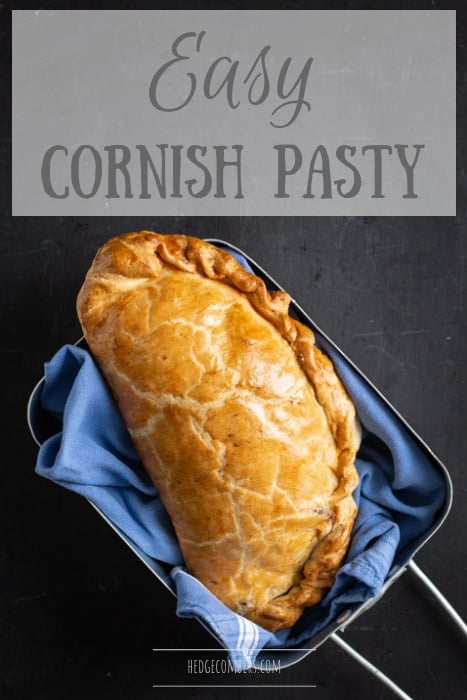
This post has been updated for 2020
A traditional Cornish pasty hails from the small county of Cornwall, at the very South West tip of England.
It’s the ultimate on-the-go meal, originally being baked for miners to take down into the mines.
The crust was designed to be held, as the ‘body’ of the pasty was eaten.
The crust would then be thrown away as miners hands were often contaminated by heavy metals and other poisons. And of course, they wouldn’t have had access to clean or running water in the tin or copper mines of the 19th century.
How to make a GREAT Cornish Pasty!
There are three keys to making the perfect pasty:
PASTRY
The pastry needs to be a buttery shortcrust, that flakes a little. It also needs to be dark, golden brown. No pale, anaemic looking pasties please!
MEAT
Traditionally beef skirt is used in a Cornish pasty. It needs all gristle removing, then should be diced finely and spread evenly throughout the pasty to avoid finding a great clump of meat at one end, with no meat at the other.
SEASONINGS
This should actually be number one on this list. As without a really good sprinkle of salt & black pepper, a perfectly good pasty will be bland and inedible.
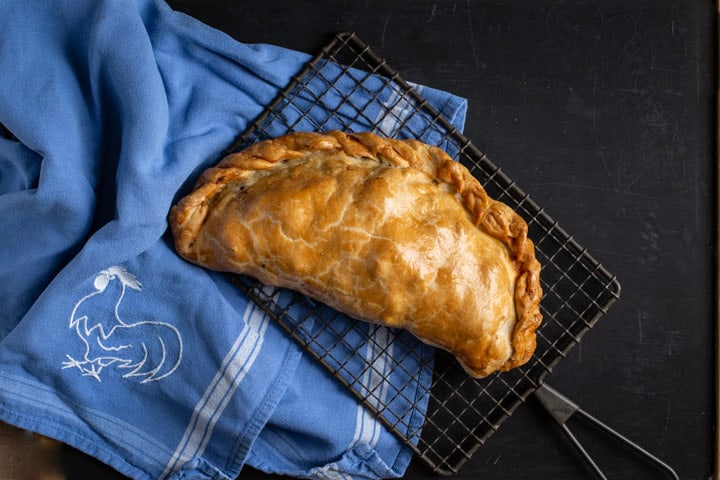
What’s in a Cornish Pasty?
Along with the pastry, beef skirt and plenty of seasoning, you’re also going to need…
- Potatoes. Choose a waxy potato rather than a floury one. The latter will simply disintegrate in baking. Secondly, I was always taught to ‘chip’ my potatoes rather than dice them. I’ve made it both ways, and honestly, there is no difference in taste. However, you’ll have generations of Cornish bakers smiling down on you if you chip rather than dice :)
- Swede/Turnip. Apparently, there is a little confusion on this vegetable. The swede/turnip we use is the yellow-fleshed variety. For authenticity sake, please avoid the white-fleshed ones. The one below is possibly the largest swede I’ve ever seen and I only used one small slice of it for three pasties!
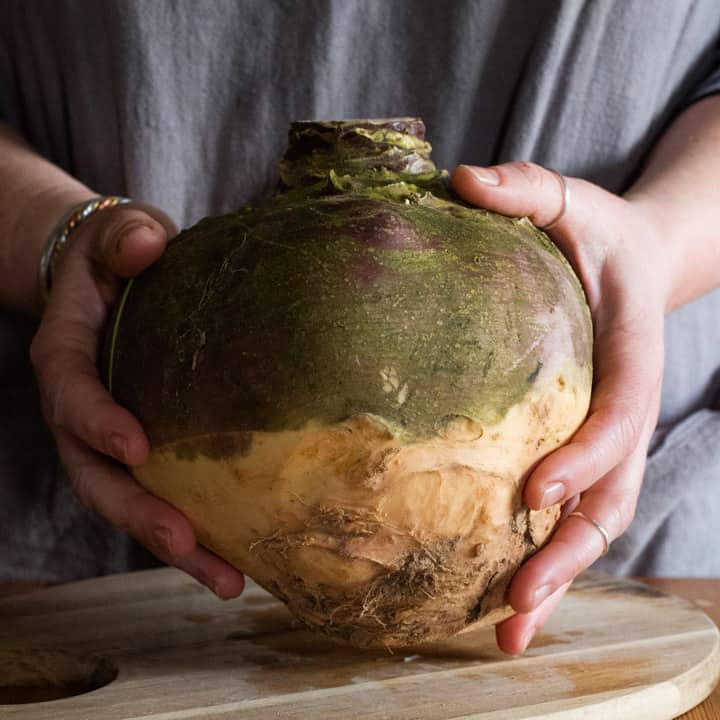
What NOT to put in a Cornish Pasty!
Carrot. DO NOT PUT CARROT ANYWHERE NEAR A TRADITIONAL CORNISH PASTY.
It is a sin, and you will get pooped on by every seagull in Cornwall.
Same for peas. Urgh.
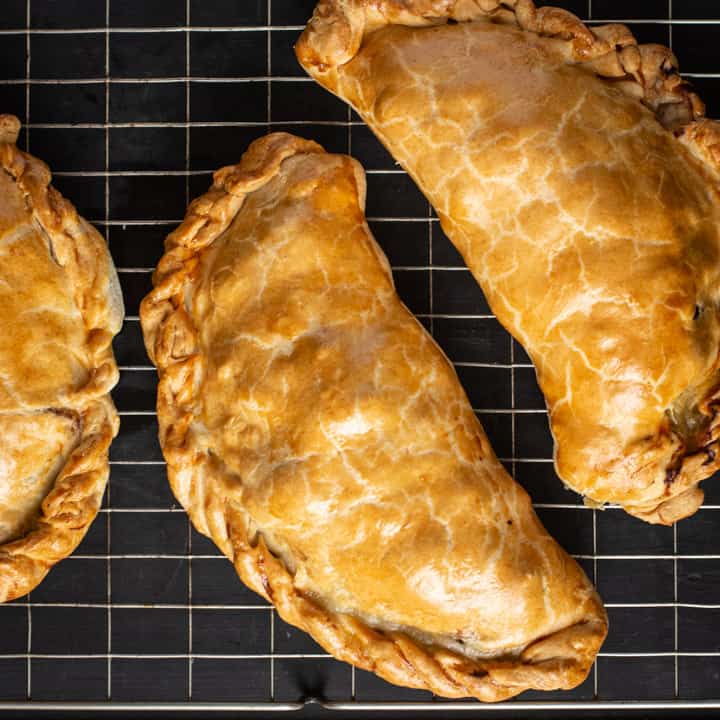
Step by Step Guide to Making a Traditional Cornish Pasty!
1: Prep your Pasty Filling
The way I was taught (by a lovely Cornish man in his 90’s who had made pasties his entire life) was to ‘chip’ the potato rather than dice it.
To do this, take a small paring knife, and gently chip away at the potato.
Cutting away small pieces that almost resemble flower petals.
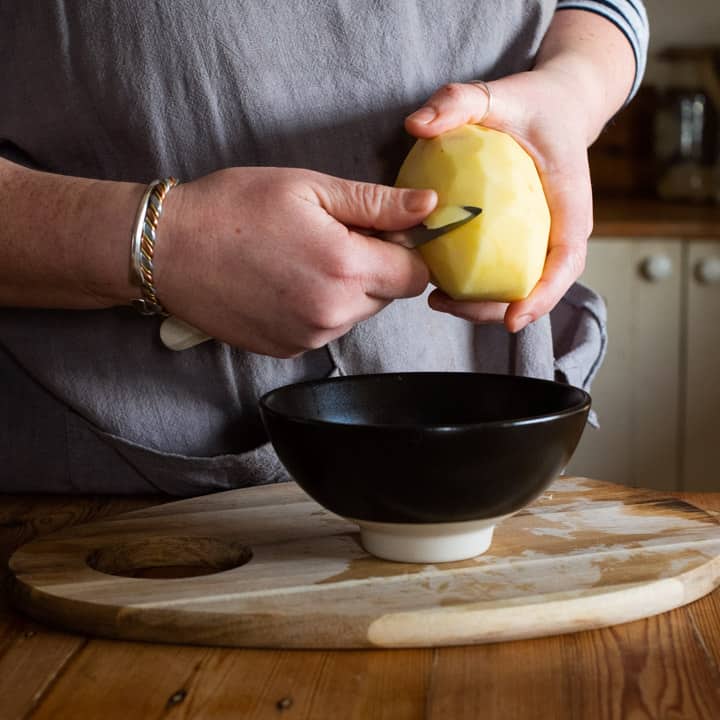
Repeat with the swede.
Then finely dice the onion.
Finally, chop your beef skirt into small pieces, removing any tough or gristly looking pieces.
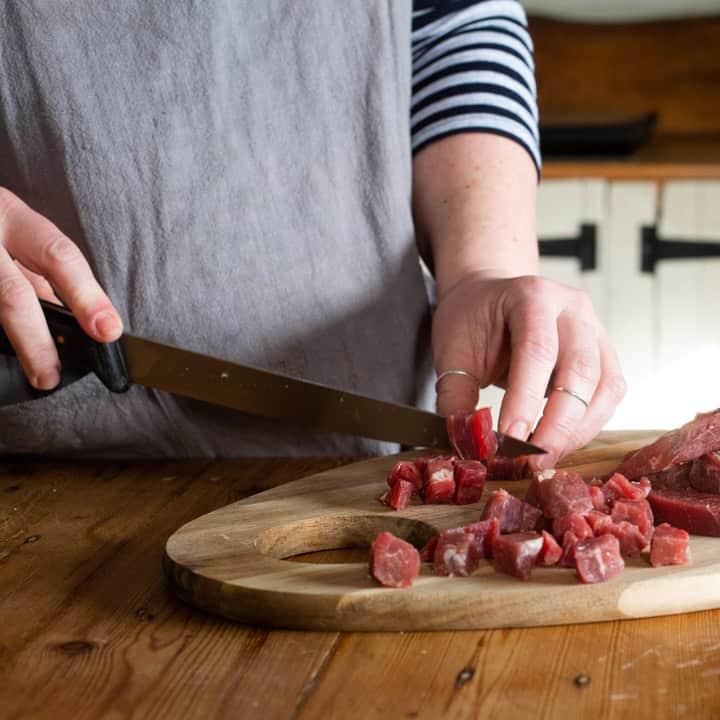
2 Roll out Your Pastry
You can make shortcrust pastry from scratch, or buy the ready-made version if you are short on time.
Either way, roll the pastry out. Then draw around a plate that is roughly 20cm in diameter with a sharp knife.
Lay the pastry rounds out on the work surface that has been lightly dusted with flour.
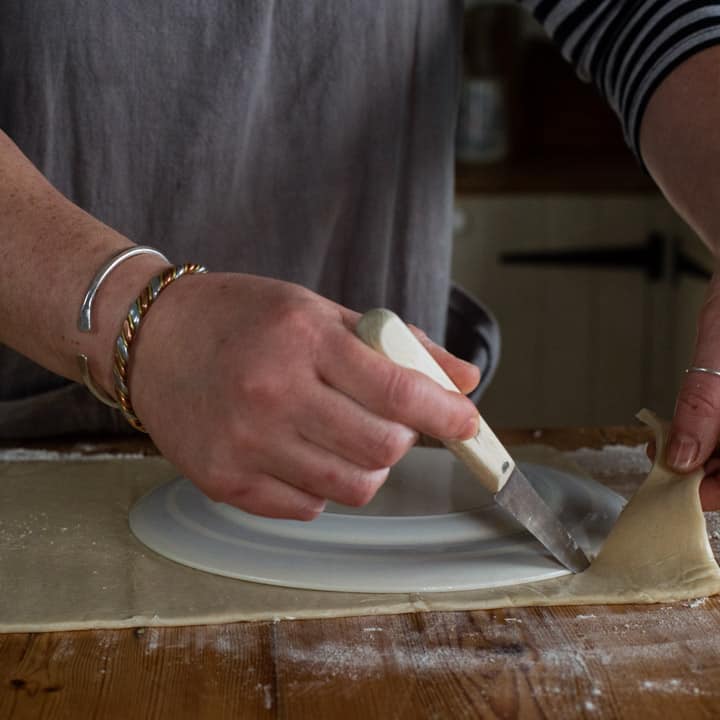
3/ add the pasty filling
It really doesn’t matter what order you do this in.
But I tend to do the potato first so that the meat juices will drip down a baste the potato as it cooks.
Next up I add the onion, swede and finally the beef.
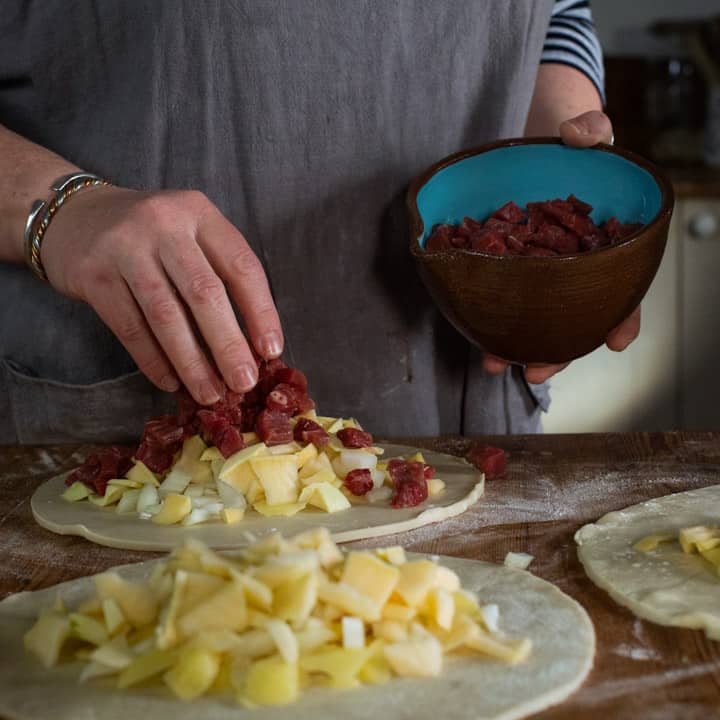
4/ add the pasty seasonings
You’ll need LOTS of black pepper and a really good sprinkle of salt (for authenticity it should really be Cornish Sea Salt!)
Finally a goodly sized knob of butter which I tend to cut into three so that it will flavour the entire pasty evenly.
Whilst butter is most commonly used these days, you could switch it out with a knob of clotted cream instead if you have any. Many old pasty recipes note either butter or clotted cream.
The fat in the butter or cream will baste all the ingredients and create a deliciously moist filling.
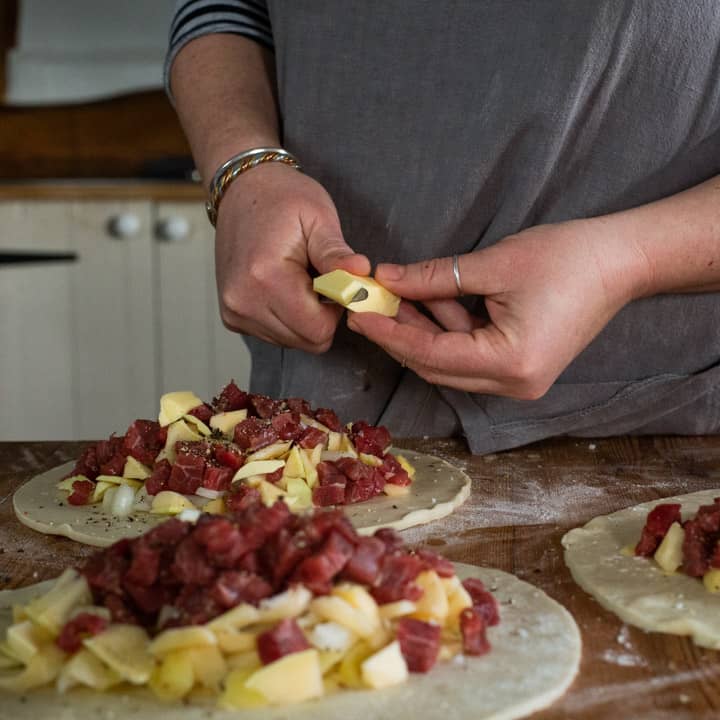
5/ fold and seal the pastry
OK, I’m not gonna lie, this bit is tricky the first few times you do it.
Firstly, fold the nearest edge of pastry over the filling, away from you. Whilst also trying to stop everything from falling out.
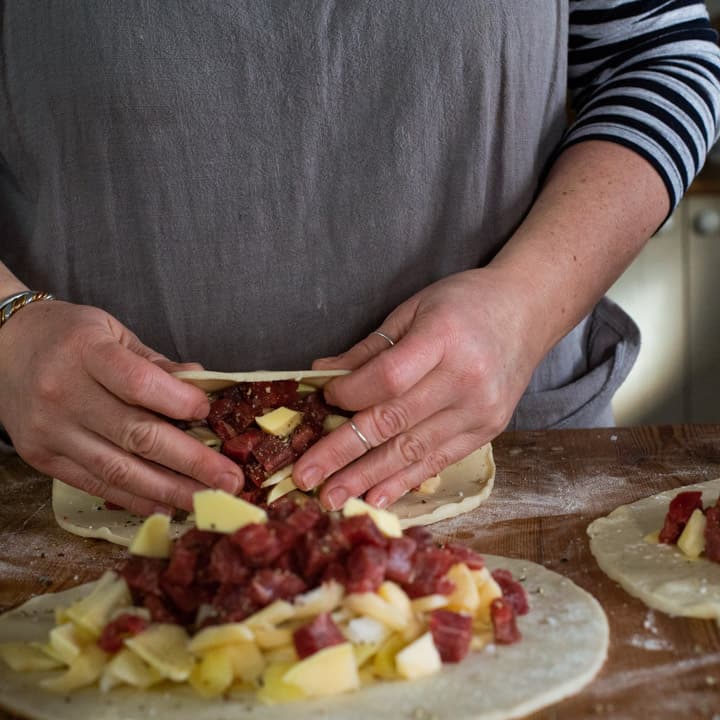
Then press the pastry edges together.
Again poking any stray filling pieces back inside.
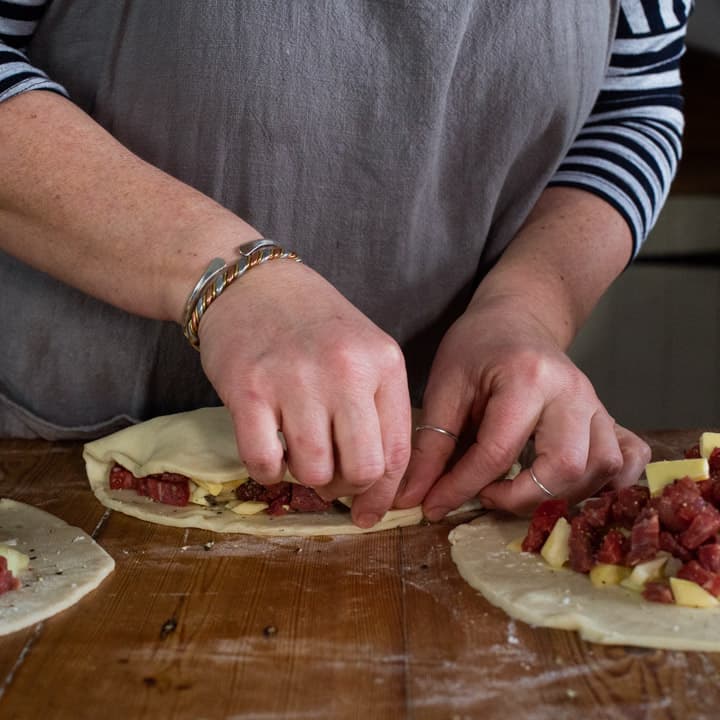
And finally, pinch the edges together along the length.
You don’t need to egg or milk wash the edges to make the pastry stick.
6/ how do you crimp a Cornish pasty?
Start at one end and fold the very end inch of pastry over itself, pressing down firmly.
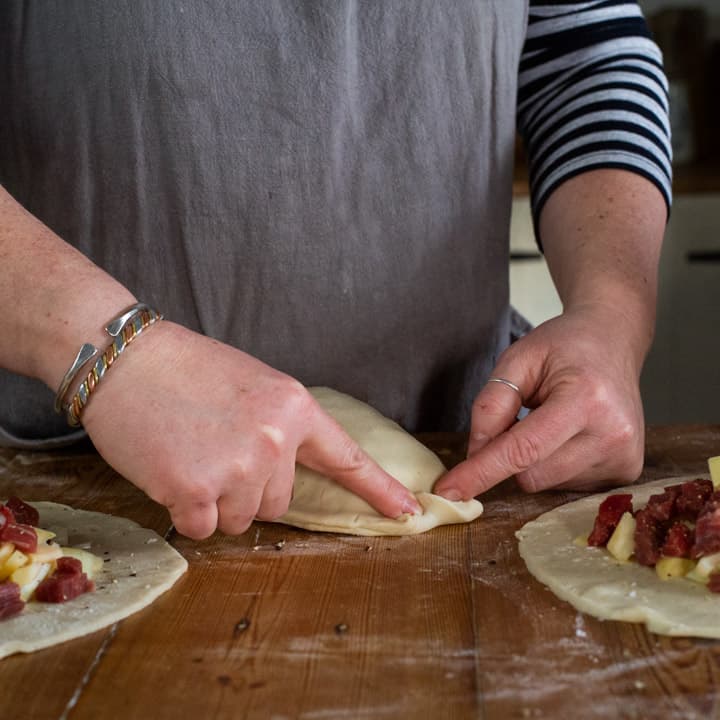
Fold the next inch of pastry and press down.
Then repeat along the entire length.
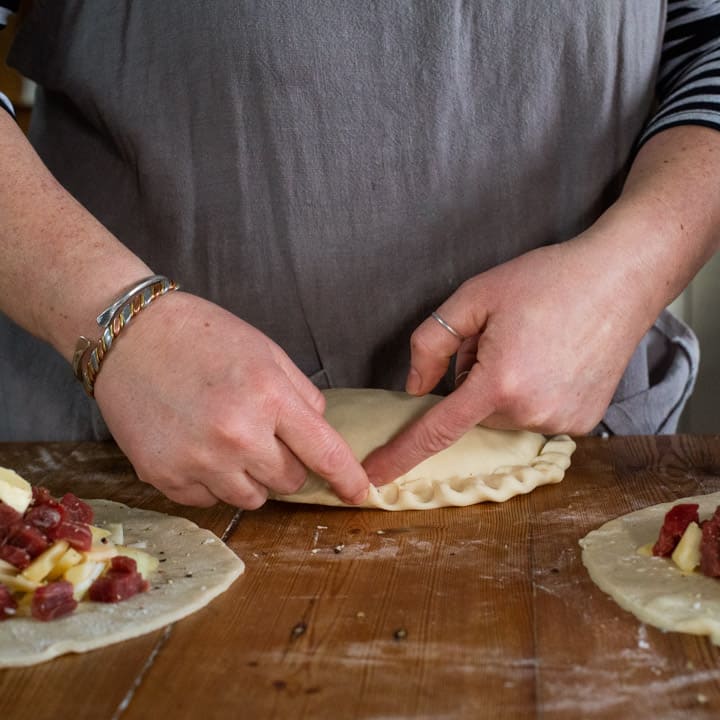
When you reach the far end, you’ll be left with a ‘sticky out’ piece of pastry an inch or two long.
Simply fold this piece underneath the pasty for a tidy finish.
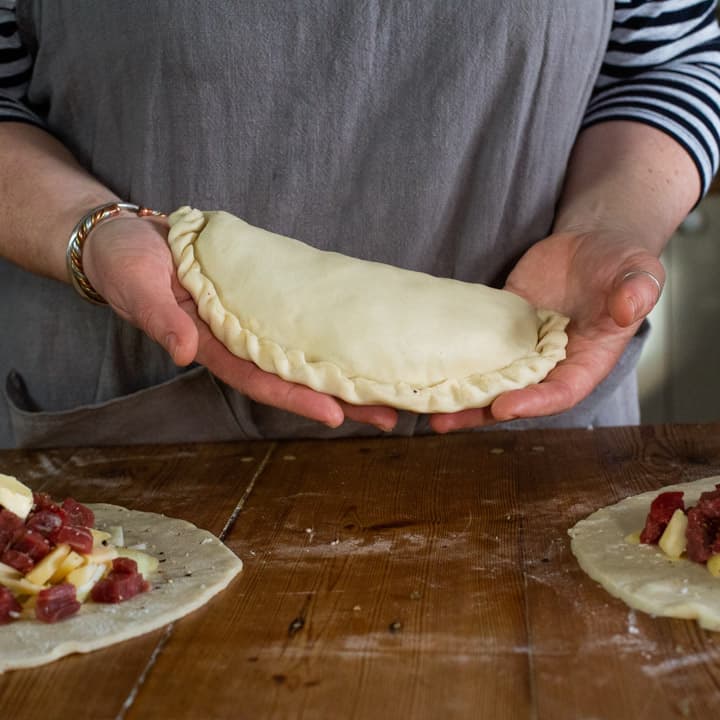
If my explanation on how to crimp a pasty has left you at all confused, please watch this video I made at the World Pasty Championships at the Eden Project.
Feel free to skip forward in the video to 11.50 for the recipe only. Or 12.51 for the pasty crimping action!
7/ egg (or milk) wash
I’ve never heard whether egg or milk is the most traditional wash for a Cornish pasty. But I always use egg as I’m lactose intolerant.
If you opt for egg too, do make sure you beat it really well so the yolk and white are fully combined.
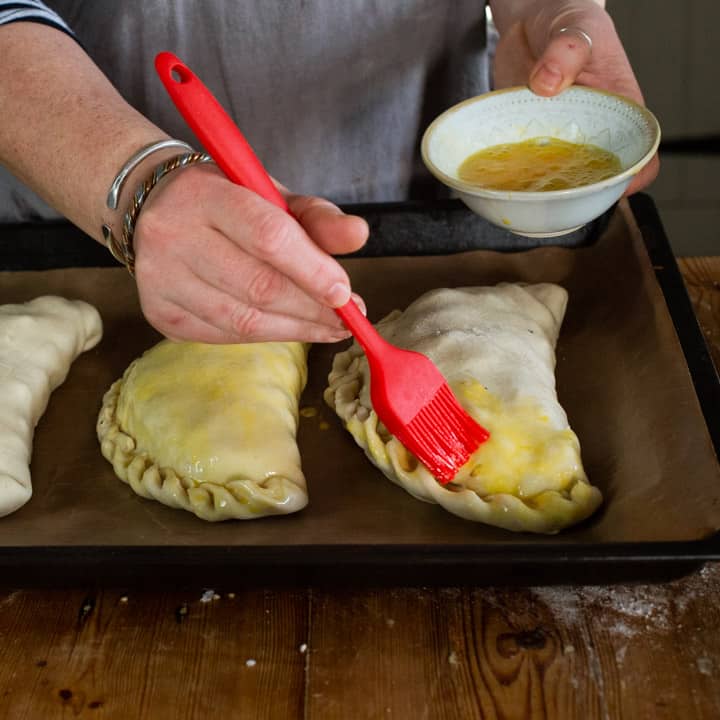
Then simply brush liberally over the pasty and crust with a pastry or basting brush.
At this point, you’ll pop the baking tray into a preheated oven.
Then tap your fingers impatiently for the next 50 minutes whilst your house fills with the glorious scent of baking Cornish pasties!
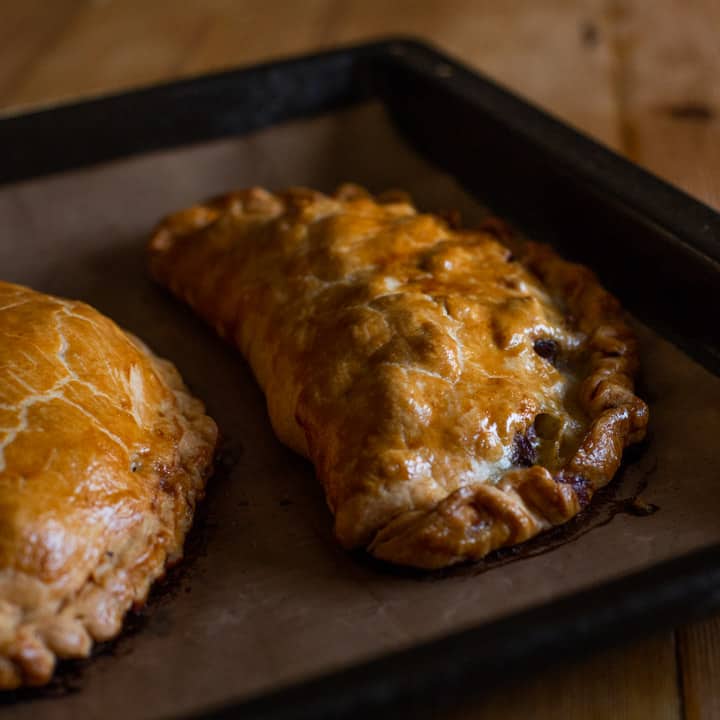
When they are cooked, you can eat them immediately or let them cool.
They are a complete meal so don’t need any side dishes. But a side salad would work well if you wanted to get some extra veggies in.
Can you Freeze Cornish Pasties?
Yes! They freeze perfectly.
Once they are baked, place on a cooling rack until room temperature.
Move to the fridge until they are cold. Then wrap well in cling film or foil.
Write the name and date on the foil with a sharpie, then place them in the freezer.
If you are freezing several pasties, spread them out in the freezer overnight. This will protect them from getting squished, and prevent your freezer temperature from fluctuating too much.
Once they are frozen solid, you can gather them all up into one large ziploc bag if you like.
How do I defrost a frozen pasty?
To defrost, leave overnight in the fridge. By lunch time the next day your pasty should be ready to eat cold, or you can reheat it.
To reheat a Cornish pasty, preheat your oven to 180C/350F. Place the unwrapped pasty on a baking tray and cook for 15 minutes, or until the centre is piping hot.
Can I cook a pasty from frozen?
Yes, absolutely.
Simply preheat the oven to 180C/350F and cook for around 40 minutes, or until the middle is piping hot.
Where can you buy the best Cornish pasty?
If you’re visiting Cornwall and you want to avoid buying a bad pasty (of which sadly, there are many), my absolute favourite pasty shop is Sarahs Pasties in Looe.
It’s the tiniest little bakery and you can watch the girls make them every morning.
They also have a sister cake shop down the road for pudding ;)
Oh, and they all deliver nationwide, so no need to wait until your next visit!
And if you’ve enjoyed this easy Cornish pasty recipe, you might like to take a peep at my entire category dedicated to Packed Lunch Recipes!
Or if you’d like to head directly to one of my readers favourite recipes, check out this Authentic British Pork Pie recipe. It’s divine!
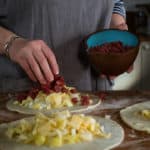
- 500 g shortcrust pastry
- 150 g potato chipped or diced
- 75 g swede chipped or diced
- 75 g onion diced
- 200 g beef skirt diced
- 30 g butter
- 1 egg beaten
- salt and pepper lashings of!
Preheat the oven to 165c and line a large baking sheet with baking paper.
Roll out your shortcrust pastry and cut round a 20cm plate to make a circle of pastry. Lay out on a work surface dusted lightly with flour.
Repeat with the remaining pastry so you have 3 pastry circles.

Lay 1/3 of the potato, swede, onion and finally beef skirt on the centre of each circle. Aim to have the ingredients well spread out so as each bite gets a mix of flavours.
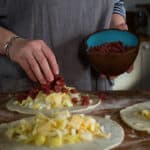
Add a small knob of butter on top of each pile of ingredients.
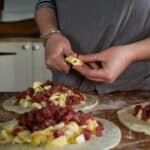
Season extremely well with salt and pepper.
This step is vital, please don't skimp!
You want to feel the heat from the black pepper as you eat your pasty.

Fold one pastry side over to meet the other, enveloping all the filling in.
If any bits stray, simply poke them back in.
Gently press the two edges together Gently but firmly.

Starting at one end, fold the very last inch of the pastry ’seam’ over itself.
Continue with this action to crimp the entire ‘seam’ together which will create a sealed edge along the pasty.

Lay out on the lined baking sheet, then brush generously with the egg wash.
There’s no need to pierce a hole in your pasty, try to keep the pastry intact if you can.
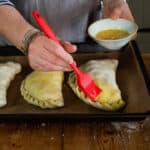
Bake in the preheated oven for 50 minutes.
Remove and devour hot, or let cool fully on a wire cooling rack before packing away in a lunch box.


Sarah Brewer says
My granny made teh best Cornish pasties ever. Just one comment, maid, most people north of the Tamar will think chipping your potatoes means cutting them into … um… chips. I can must imagine a series of pasties containing logs of potato!. Chipping is a very delicate, skill that usualy involves a cut thumn when youfirst start learning it as teh shirt, peeling knife is whipped to and fro over the top of the teddy. :)
Jane Sarchet says
So funny you left this comment Sarah, I actually filmed me ‘chipping’ those potatoes, yet couldn’t fit that clip into the video anywhere where it made sense! You’re right, I will add a little piece about the correct style of chipping to be used ;)
Thanks for your comment, don’t suppose you have your grannies recipe still do you?
Sarah Brewer says
I do! I will photocopy and send to you when I get chance.
Jeff the Chef says
I’m guessing that you know that Cornish people, long ago, emigrated to Michigan’s Upper Peninsula (the UP), and made pasties famous there. The UP is a kind of a off-the-beaten-path place, so pasties are a sort of special secret that just a few lucky people know about. I grew up close enough to the UP to be well acquainted with them – and just like in Cornwall, you don’t dare put a carrot in one! The big debate in the UP is whether or not you put gravy on them.
Martin in Bayern says
Funny, I lived in Michigan UP (Houghton) for a while and have to say that even though I grew up in the West Country in Britain, fairly close to Cornwall, I enjoyed the most delicious pasties in the UP!
Marty Boyer says
This Washingtonian/Californian has loved pasties all her life and reveled in them while traveling in UK. Best US pasty experience: A tiny pasty shop in Marquette, Michigan I was referred to as I drove the entire circle trip around Lake Michigan. Drove nearly 100 miles out of my way to get that pasty and see Marquette in pouring rain. It was so worth it.
Jane Sarchet says
Wonderful memory!
Janie x
Sharon Nicholas says
As Jeff the chef mentioned, the UP of Michigan is well known for It’s pasties. I live in a small town in the UP (Ishpeming) and have been making pasties all of my married life…42 years. My mother, grandmother, and great grandmother made them, too. There are a lot of pasties shops around, but there’s nothing better than a homemade pastie. I make the traditional Cornish pasties using a “hot water” crust. Generally, when you make the decision to make pasties, you make a lot of them. I usually make a dozen at least. So it’s an afternoon’s endeavor, but so much fun……I love making them. Ketchup is the condiment of choice in my family, no gravy here.
Jane Sarchet says
Thank you for your lovely comment Sharon, I love hearing how foods are enjoyed all around the world :)
Jane x
Ricardo Amore says
I LOVE this woman, and her passion for food! I chanced upon this site looking for Cornish pasty recipes, and got snatches of rain forest and container architecture – not to mention her fabulous way of telling a story. I haven’t had enough Cornish pasty experience to share her prejudices – No peas! No carrots! No feeding the nib to a seagull! – but I love that she has them. And her recipe is straightforward and do-able. Thank you from the USA, specifically from Tacoma, where we all HATE Donald Trump. And LOVE Cornwall – particularly at Christmas.
Jane Sarchet says
Oh Ricardo, what a lovely message. Thank you!
So tell me, how did you end up looking for a Cornish Pasty recipe in the first place? Have you visited Cornwall all the way from Tacoma, or does your family originate from here? Do tell :)
Janie x
Raymond Moyse says
Jane, thanks for showing how to chit spuds for pastie you are the first to show the correct way spuds should be cut, I used to watch my Gran do them that way when I was a lad, I’m 86 in June, and I make them the same way, but what you left out was the last bit of crust was thrown in the corner of the mine to feed the knockers, who if not fed would do all sorts of nasty things the least being stealing tools, and also when gran and mum made pasties they were large so the you could eat 2 thirds of it for tea and save the last bit for supper when you came back from the pub, which I did also when I was able to go to the pub.
Jane Sarchet says
Ah Raymond, thank you for your lovely message! The idea of making a pasty so large that you had the leftovers for tea is genius, your Mum & Gran were pretty smart huh?!
I hope you’re staying safe at this crazy time, and that you can still make/buy a decent pasty to see you through lockdown :)
Stay safe
Jane x
Maralyn Miller says
My Grandma’s family migrated to Adelaide, Australia from Cornwall in the 1800’s, and Grandma made Cornish Pasties every week for us while I was growing up. She had a mincing machine, so minced all the vegetables, and I admit she substituted Carrots for Swedes or Turnips because as I child I couldn’t stand them. I still make Pasties, fairly unusual in Australia, but my husband now asks for them.
Jane Sarchet says
I love this Maralyn, thank you so much for sharing :)
Jane x
Jen says
Marilyn, I too am in Adelaide now but I hail from Cornwall. We recently moved to SA and visited Moonta last year to have a pasty and see the tin mining museum, have you been? I learned my recipe from my Nanna who btw was an award winning pasty chef working out of the Pandora Inn in Mylor. She made us pasties with our names on the top and as a treat let us eat them with baked beans! Her cheat was frozen ASDA pastry if you’re short of time!!
Jane Sarchet says
Haha, love this Jen! (And I’m with her on the pre-made pastry!)
Janie x